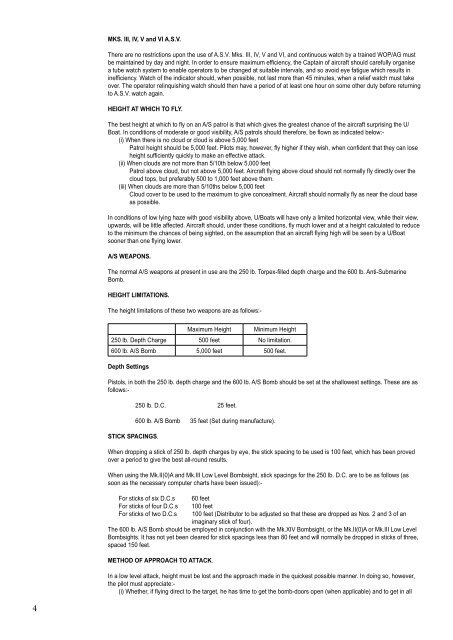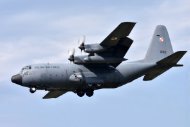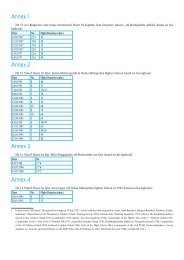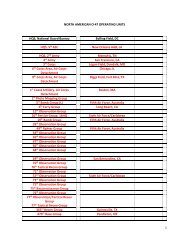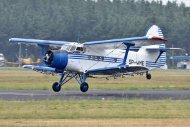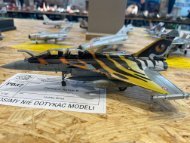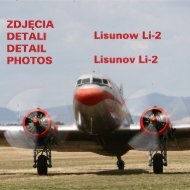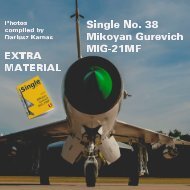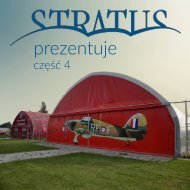B-17 CC Additional Material by Robert M Stitt
Boeing B-17 Fortress in RAF Coastal Command Service Second Edition Robert M Stitt Additional Material
Boeing B-17 Fortress in RAF Coastal Command Service
Second Edition
Robert M Stitt
Additional Material
- No tags were found...
You also want an ePaper? Increase the reach of your titles
YUMPU automatically turns print PDFs into web optimized ePapers that Google loves.
MKS. III, IV, V and VI A.S.V.<br />
There are no restrictions upon the use of A.S.V. Mks. III, IV, V and VI, and continuous watch <strong>by</strong> a trained WOP/AG must<br />
be maintained <strong>by</strong> day and night. In order to ensure maximum efficiency, the Captain of aircraft should carefully organise<br />
a tube watch system to enable operators to be changed at suitable intervals, and so avoid eye fatigue which results in<br />
inefficiency. Watch of the indicator should, when possible, not last more than 45 minutes, when a relief watch must take<br />
over. The operator relinquishing watch should then have a period of at least one hour on some other duty before returning<br />
to A.S.V. watch again.<br />
HEIGHT AT WHICH TO FLY.<br />
The best height at which to fly on an A/S patrol is that which gives the greatest chance of the aircraft surprising the U/<br />
Boat. In conditions of moderate or good visibility, A/S patrols should therefore, be flown as indicated below:-<br />
(i) When there is no cloud or cloud is above 5,000 feet<br />
Patrol height should be 5,000 feet. Pilots may, however, fly higher if they wish, when confident that they can lose<br />
height sufficiently quickly to make an effective attack.<br />
(ii) When clouds are not more than 5/10th below 5,000 feet<br />
Patrol above cloud, but not above 5,000 feet. Aircraft flying above cloud should not normally fly directly over the<br />
cloud tops, but preferably 500 to 1,000 feet above them.<br />
(iii) When clouds are more than 5/10ths below 5,000 feet<br />
Cloud cover to be used to the maximum to give concealment. Aircraft should normally fly as near the cloud base<br />
as possible.<br />
In conditions of low lying haze with good visibility above, U/Boats will have only a limited horizontal view, while their view,<br />
upwards, will be little affected. Aircraft should, under these conditions, fly much lower and at a height calculated to reduce<br />
to the minimum the chances of being sighted, on the assumption that an aircraft flying high will be seen <strong>by</strong> a U/Boat<br />
sooner than one flying lower.<br />
A/S WEAPONS.<br />
The normal A/S weapons at present in use are the 250 lb. Torpex-filled depth charge and the 600 lb. Anti-Submarine<br />
Bomb.<br />
HEIGHT LIMITATIONS.<br />
The height limitations of these two weapons are as follows:-<br />
Maximum Height Minimum Height<br />
250 lb. Depth Charge 500 feet No limitation.<br />
600 lb. A/S Bomb 5,000 feet 500 feet.<br />
Depth Settings<br />
Pistols, in both the 250 lb. depth charge and the 600 lb. A/S Bomb should be set at the shallowest settings. These are as<br />
follows:-<br />
STICK SPACINGS.<br />
250 lb. D.C. 25 feet.<br />
600 lb. A/S Bomb 35 feet (Set during manufacture).<br />
When dropping a stick of 250 lb. depth charges <strong>by</strong> eye, the stick spacing to be used is 100 feet, which has been proved<br />
over a period to give the best all-round results.<br />
When using the Mk.II(0)A and Mk.III Low Level Bombsight, stick spacings for the 250 lb. D.C. are to be as follows (as<br />
soon as the necessary computer charts have been issued):-<br />
For sticks of six D.C.s<br />
For sticks of four D.C.s<br />
For sticks of two D.C.s<br />
60 feet<br />
100 feet<br />
100 feet (Distributor to be adjusted so that these are dropped as Nos. 2 and 3 of an<br />
imaginary stick of four).<br />
The 600 lb. A/S Bomb should be employed in conjunction with the Mk.XIV Bombsight, or the Mk.II(0)A or Mk.III Low Level<br />
Bombsights. It has not yet been cleared for stick spacings less than 80 feet and will normally be dropped in sticks of three,<br />
spaced 150 feet.<br />
METHOD OF APPROACH TO ATTACK.<br />
In a low level attack, height must be lost and the approach made in the quickest possible manner. In doing so, however,<br />
the pilot must appreciate:-<br />
(i) Whether, if flying direct to the target, he has time to get the bomb-doors open (when applicable) and to get in all<br />
4


